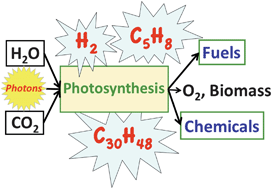100 years ago an Italian chemist predicted that one day human beings would use sunlight to make fuel.
Professor Giacomo Ciamician, nine-time Nobel Prize nominee, envisaged a time when human beings would use “processes that hitherto have been the guarded secret of the plants” to harvest sunlight and make fuel.
To celebrate the remarkable recent scientific advances towards achieving this dream, the RSC has created a collection articles by leading international scientists as well as original commentaries setting out their opinions about the future. All articles in the collection are free to access until 27th October 2012.

“Fast food” energy – Daniel Nocera argues that new research and development is needed to provide the nonlegacy world with the “fast food” equivalent of solar energy—light-weight and highly manufacturable solar capture and storage systems (Energy Environ. Sci., 2010,3, 993-995).
Running on sun – five international experts discuss the promise of artificial photosynthesis and the challenges that lie ahead (Published on the 25th of September 2012).
Which energy solution is best?
Review of solutions to global warming, air pollution, and energy security – Mark Jacobson reviews and ranks major proposed energy-related solutions to global warming, air pollution mortality, and energy security (Energy Environ. Sci., 2009, 2, 148-173).
Learning from Nature
Photosynthetic energy conversion: natural and artificial – James Barber asks: can we address the energy/CO2 problem by developing new photochemical technologies which mimic the water splitting enzyme of photosynthesis? (Chem. Soc. Rev., 2009, 38, 185-196).
Recent advances in hybrid photocatalysts for solar fuel production – Joachim Loo and colleagues investigate how to make robust photocatalytic hybrid
Photosynthesis-to-fuels: from sunlight to hydrogen, isoprene, and botryococcene production – Anastasios Melis explains how the primary products of photosynthesis can be transformed directly, in a single organism, into useful fuels and chemicals for human consumption (Energy Environ. Sci., 2012, 5, 5531-5539).
Raising awareness
Solar Fuels and Artificial Photosynthesis: Science and innovation to change our future energy options is a non-technical RSC report introducing the potential of solar fuels to become a viable alternative in our future energy landscape.














